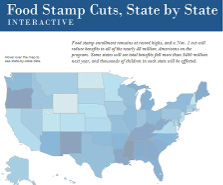Pew Resources on Food Stamp Changes
Congressional changes to the Supplemental Nutrition Assistance Program, or SNAP, that went into effect Nov. 1 reduced food stamp benefits to approximately 48 million Americans enrolled in the program.
The Health Impact Project, a collaboration of the Robert Wood Johnson Foundation and The Pew Charitable Trusts, is conducting a health impact assessment to examine the effects of changes to SNAP's eligibility and benefit levels. The Health Impact Project released a white paper in March examining the health implications and health-related costs of the proposed changes.

View the interactive map. |
Members of the Health Impact Project team will present their findings at the American Public Health Association's annual meeting Nov. 2 - 6, 2013 in Boston.
The comprehensive, nonpartisan analysis details how changes to SNAP (previously known as food stamps) could affect the U.S. poverty rate, disease rates—including diabetes—and associated medical costs, among other things. The goal of the project is to ensure that potential health effects and related costs are a part of the policy discussion.
How will a reduction in supplemental nutrition assistance affect your state? View the interactive map of state-by-state data on the number of enrollees in the program and cuts to the program.
Additional resources:
- Stateline interactive: “Food Stamp Cuts, State by State”






